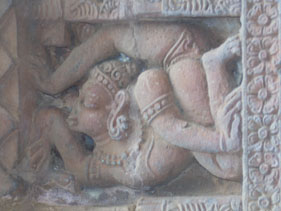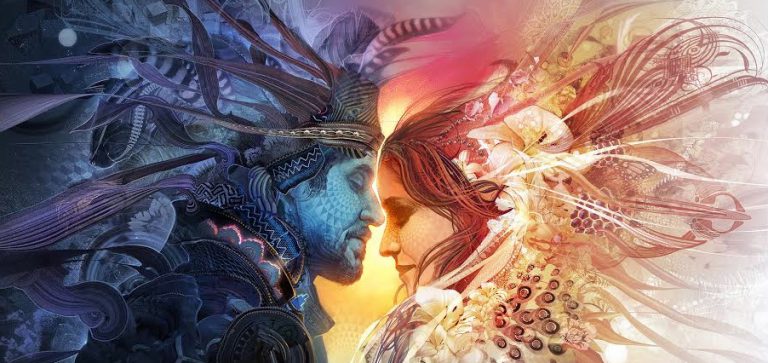Tantra -the art and science of being alive
What is tantra? The word tantra comes from India and Tibet. It is the science and the art of being alive, based on practices that…
What is tantra?
The word tantra comes from India and Tibet. It is the science and the art of being alive, based on practices that consciously explore life experientially. This practical exploration covers:
- what does it mean to be a man? to be a woman? how can men and women really meet?
- what is the depth of love? what is the height of sex?
- how to create a fulfilling relationship without fear of rejection while staying true to yourself?
- what is god/spirit?
- what is death and how can it have meaning?
- Desire, passion, pleasure – are they selfish or can they be spiritual?
- how to be attached – committed, caring, passionate – and at the same time non-attached – selfless, tranquil, trusting?
- What is the sense of life?
- What is the most beneficial interaction between body, mind and spirit?
- what is the nature of experience and perception? what is the relationship between the perceiver and the perceived?
- how is consciousness different from thinking?
- how do I distinguish truth from illusion?
- how to feel more alive, become more charismatic and attractive to others?
- how to create the reality that fulfills you?
In fact all the fundamental questions of life.
Tantra has answers to all these questions: it also has many explanations of how life works based on an understanding of energy, which is not part of our mechanistic culture, yet a grasp of which enables us to interact creatively with many aspects of life that were previously mysterious forces by which we were helplessly buffeted: relationships, love, sexuality, fate.
 Above all, tantra does not prescribe answers: unlike religion, it does not tell you what to think and believe. It gives you structures to explore these themes experientially and personally, and then to come to your own conclusions based on these experiences. The only authority in tantra is your own heart, your own sense of what is true for you and what your spirit needs to follow.
Above all, tantra does not prescribe answers: unlike religion, it does not tell you what to think and believe. It gives you structures to explore these themes experientially and personally, and then to come to your own conclusions based on these experiences. The only authority in tantra is your own heart, your own sense of what is true for you and what your spirit needs to follow.
If you are interested in these burning life questions if you want to find your own answers not just be given them by a higher authority, if you want to spend time with other people who want to explore what is the sense of life and how relationships function, then tantra is for you. It covers the subjects they didn’t dare explore at school!
Tantra is for free thinkers, for rebels, for non-conformists,
for seekers of alternatives,
for lovers, and lovers of life,
for truth seekers,
for seekers of excitement, for seekers of tranquillity,
for seekers of meaning, making sense of existence,
for seekers of pleasure and delight,
for those who seek god,
for those who seek themselves.
What can the tantric path offer me?
- Enjoy more energy and aliveness
- Develop the ability to relax, to get out of your head, and be open to experience life at the moment
- open your heart to love – of yourself and of your partner
- find more sensitivity to touch and to energy
- experience lovemaking as an exchange of energy
- connect your sex with your heart and your spirit
- feel your value and beauty, feel your desirability
- experience many ways of enjoying and expressing and sharing sexual energy as well as or instead of genital sex
- Develop witness consciousness to not have your buttons pressed, but be free of self-destructive behaviour
- Find freedom from addiction and obsessiveness
- learn to become more present and focused
- learn how to keep a long-term partnership alive and sexy
- learn how to prolong lovemaking and choose when and if to ejaculate
- be able to surrender to the pleasurable streamings of aliveness and energy through your body
- free yourself from self-consciousness and self-criticism and experience life directly and immediately.
- Be free to choose the reality you wish to create and live.
The Background of western tantra.
The word tantra has several meanings, one of which is that of “scriptures”, words of wisdom that have been taught orally by a teacher, and then written down, words of experience rather than words of a theory or philosophy. Many texts go back as much as 4000 years, and the wisdom itself is thought to come from pre-Vedic, tribal times. The body of knowledge is arrestingly similar to that taught as fire medicine in the Native American tradition, and there is good reason to believe that it is the remains of ancient culture from times when people lived close to the earth, the goddess was honoured, and the relationship between men and women was not an expression of property but a celebration of the mystery of life, seen in the macrocosm as the embrace of the sun and the earth, and in the microcosm as the miracle of perception embodied in the dance of Shiva and Shakti as consciousness and energy, sperm and egg meet to create new life.
With the advent of the major religions, tantra went underground, and became an esoteric tradition that still exists in quiet places, but maligned and distorted by the public imagination – in the West as sex orgies, in India as black magic. This successfully frightens many people away from experiencing its life-enhancing and consciousness-expanding teachings.
Tantra divides into two major traditions: the right-handed path and the left-handed path. Both see the universe arising out of the ecstatic dance and sexual union of the feminine and masculine principles, energy and consciousness, represented in the forms of god and goddess.
The right-handed path works with sexual energy through sublimation, visualization, and meditation as worship of these principles.
The left-handed path challenges the follower to embody these energies, to become the god or the goddess and manifest energy and consciousness in themselves, in their thoughts and actions, in their awareness.
The left-handed path is practised not only by professionals, priests or monks withdrawn from life but by ordinary women and men living in the middle of life, in the market place. Relationships, and especially one’s primary sexual relationship, can, therefore, become the conscious spiritual path of growth.
Instead of repressing desire and sexuality and pleasure as a distraction from the spiritual path of transcendence, the student gives the self into it completely, letting it become the tattva, the gateway, through which to lose the ego in the surrender to that which is greater than the self. Desire followed with totality and abandon takes one beyond, beyond the duality of attachment or non-attachment, guilty or not guilty, sexual or spiritual, into being innocently in bliss.
In the 1970s the Indian mystic Osho, previously known as Rajneesh or Baghwan, created a blend of tantra and humanistic psychotherapy that became tantra for the West. This was brought to Europe by Margot Anand as SkyDancing Tantra, by Michael Plesse and Gabriele St Clair of Orgoville International to Germany, and in a later wave by Sarita in France/UK and Astiko in Spain as Osho neo-tantra. Daniel Odier teaches Kashmiri Shivaite tantra in Paris. Margot trained teachers in 1991-2 and set up SkyDancing Institutes in the USA, Germany, Switzerland, the Netherlands, and France.
Some traditionally-minded tantric students and practitioners fear that the practice of left-handed tantra without long preparation and real dedication can debase the legacy of tantra and entangle workshop participants deeper in their own egos. There are indeed many tantra teachers who offer, and participants happy to consume, tantra as a new-age entertainment and social activity. The attempt to simultaneously bring together sexuality and spirituality is a high endeavour. Yet if a serious student finds an experienced and inspiring teacher she or he can live moments of transcendence and empowerment, and create lasting personal transformation. And the path, the journey itself, is full of insights, moments of joy, and positive change.






